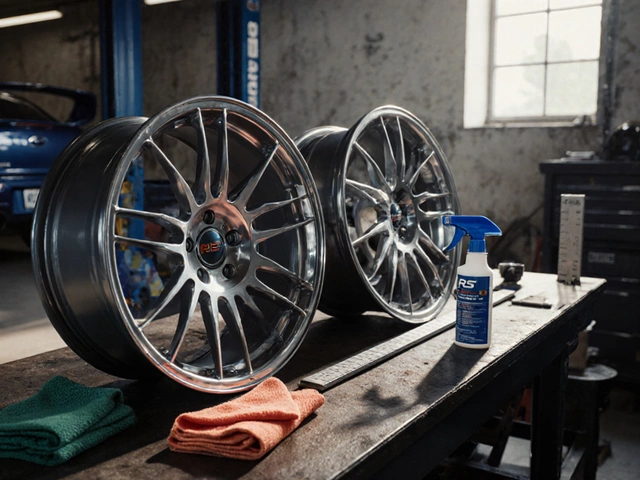Carbon fiber! You might have heard about it in sci-fi movies or when car enthusiasts talk about high-performance upgrades. It's light, strong, and, frankly, pretty cool. But, does this modern marvel have what it takes to stop a bullet? Spoiler alert—it's not as straightforward as a yes or no.
Carbon fiber is a composite material, meaning it's made by combining fibers into a matrix—think of it like a super strong, lightweight mesh. It's known for its incredible tensile strength, which makes it ideal for car spoilers. They help with aerodynamics without adding weight, boosting both fuel efficiency and speed.
When it comes to bulletproofing, though, carbon fiber's ability to stop a bullet depends on several factors like the thickness and the mix of materials used. Generally, you'd need to pair it with other materials like Kevlar or incorporate it into layered composites to handle such high-impact energy. So, it's possible, but not in the way Hollywood might have you believe.
- Understanding Carbon Fiber
- The Strength of Carbon Fiber
- Can It Be Bulletproof?
- Advantages in Car Spoilers
- Practical Applications
- Future Innovations
Understanding Carbon Fiber
Carbon fiber is often hailed as a wonder material, but what exactly makes it so special? For starters, it's all about the composition. Essentially, carbon fiber is made from strands of carbon atoms bonded together in a long chain, which are then woven into a fabric and combined with a polymer. The result is a composite material with high strength-to-weight ratio, making it ideal for automotive and aerospace industries.
Interestingly, carbon fiber's beginnings trace back to the mid-20th century, when engineers were itching for materials that could withstand high stress without the burden of heavy weight. Its widespread use today in car spoilers and other performance parts is due to its ability to improve aerodynamics while maintaining a lightweight profile. This gives cars the push they need for better speed and fuel efficiency without sacrificing safety.
Manufacturing Process
The manufacturing process of carbon fiber is intricate and requires precision. It involves carbonization where the raw material is heated to create those fantastic bonding chains of pure carbon. This is followed by processes like stabilization and graphitization, where they're baked at even higher temperatures to enhance toughness. Each step adds to the material's incredible properties but also its cost.
"Carbon fiber represents not just a material, but rather, a gateway to a future of lightweight engineering," says Dr. Lisa Yates, a materials scientist from MIT.
Practical Benefits
So, why do automakers love it? Besides strength and lightweight characteristics, carbon fiber is highly versatile. It can be molded into sophisticated shapes, allowing for innovative design applications. It's also corrosion-resistant and affords a sleek look, which is a neat bonus if you're into aesthetics. Tons of F1 cars owe their design excellence to carbon fiber.
A Peek at the Numbers
Just to give you an idea of its prowess, check out these figures:
| Property | Carbon Fiber | Steel |
|---|---|---|
| Density (g/cm³) | 1.6 | 7.8 |
| Tensile Strength (MPa) | 5,000+ | 400-550 |
| Elastic Modulus (GPa) | 230-240 | 200 |
Understanding carbon fiber's properties helps in grasping why it can range from car spoilers to potential bullet-resistant materials. As technology advances, so will its applications and advantages, keeping this material front and center in endless innovations.
The Strength of Carbon Fiber
Let's talk about why carbon fiber is a favorite in the world of high-tech materials. For starters, it's crazy strong for how light it is. Imagine a material five times stronger than steel but weighing only a third as much—sounds almost futuristic, right?
So, what's the magic behind this strength? Carbon fiber is made up of tightly bonded carbon atoms, forming a crystalline structure. These atoms align in long, parallel lines, giving the fiber its high tensile strength. The material is also incredibly rigid, which is why it's used in structural elements like car spoilers. They can handle a lot of stress without bending or snapping.
Real-world Applications
Ever wondered why high-end sports cars have a lot of carbon fiber parts? It's because of this unique combination of strength and lightweight properties. Apart from spoilers, you'll see it in aircraft components, bicycle frames, and even some mobile cases.
For those interested in performance specs, carbon fiber boasts a tensile strength of about 500 ksi (kilopound per square inch), compared to steel’s 60 ksi. This makes it not only strong but also capable of withstanding different environmental factors like temperature changes without expanding or contracting much.
A Few Fun Facts
- Despite its strength, carbon fiber can be surprisingly flexible in design. You can mold it into all sorts of shapes during manufacturing.
- It's also resistant to corrosion—no rust here.
- One of the more overlooked perks? Its impressive heat-resistant properties.
Considering these characteristics, it's not hard to see why carbon fiber is such a game-changer in various industries. It's not just about looking good and going fast; it's about delivering exceptional performance and longevity.
Can It Be Bulletproof?
The idea of using carbon fiber to stop a bullet sounds straight out of an action movie, doesn't it? Carbon fiber is famed for its strength-to-weight ratio, making it an ideal choice for a range of high-stress applications like aircraft components, race car parts, and more. But stopping a bullet? It's a whole different ball game.
Let's break it down. A single layer of carbon fiber isn't enough to stop a bullet. However, when combined with other materials, it can contribute to bullet resistance. Here's how it usually works. Engineers often layer carbon fiber with something like Kevlar, which is known for its bullet-stopping capabilities. This composite layering approach takes advantage of each material's strengths—carbon fiber's rigidity and Kevlar's durability.
To effectively stop a bullet, engineers typically create mats composed of these materials. These mats don't just rely on carbon fiber alone. They're designed in layers, with different materials bringing different properties to the table. In some cases, they might even include a layer that absorbs energy, like a sponge, to further dissipate the bullet's force.
Why aren't we using carbon fiber body armor, then? Cost is a big factor. Carbon fiber is expensive to produce, making it less practical for large-scale applications like military gear. Plus, while strong, it's not indestructible and can be brittle when it faces impacts from odd angles.
So, yes, carbon fiber can play a role in bullet-stopping composites, but it's far from being a standalone superhero in the realm of personal armor. It's more like a crucial team player, one that's used wisely in combination with other materials.
In the table below, we give a quick overview of how carbon fiber stacks up against other materials commonly used in bulletproofing:
| Material | Common Use | Cost |
|---|---|---|
| Carbon Fiber | Car parts, aerospace | High |
| Kevlar | Bulletproof vests | Moderate |
| Steel | Vehicle armor | Low to moderate |
In summary, while carbon fiber isn't a solo act in stopping bullets, it's definitely a significant supporting player when used smartly with other bullet-resistant materials.

Advantages in Car Spoilers
When it comes to making your car perform better, lighter means faster. Enter carbon fiber—a game changer for car spoilers. Why? Because it offers a unique blend of strength and weight that traditional materials like metal just can't compete with.
The first big win is in aerodynamics. Carbon fiber spoilers improve the airflow over your vehicle, reducing drag and increasing downforce. This helps keep your car glued to the road during high-speed maneuvers, making your driving experience both safer and more thrilling.
Improved Fuel Efficiency
No one loves stopping at the gas pump, right? Because carbon fiber is so lightweight, it helps in reducing the overall mass of the car. Less weight means your engine doesn't have to work as hard, improving your miles per gallon, according to some user reports by as much as 5%! That might not sound like much, but it adds up over time.
Enhanced Durability
Durability is another high point. Unlike metals, which can rust, carbon fiber withstands the elements with ease. It doesn't corrode, which means your spoiler will look brand new for years, and maintenance becomes a breeze. Plus, it's less prone to dents and scratches, making it a smart long-term investment.
- Lightweight and Strong: Perfect for performance enhancements.
- Better Aerodynamics: Reduces drag and increases handling capabilities.
- Economical in the Long Run: Lower fuel costs and long lifespans.
Overall, adding a carbon fiber spoiler isn't just about making your car look cool—though it sure does! It's about improving performance, safety, and efficiency. These days, many auto manufacturers are getting on board, offering carbon fiber options right off the factory line. Pretty slick, right?
Practical Applications
Carbon fiber is like the Swiss Army knife in the material world—versatile, strong, and ready for action. First off, let's talk cars. In the automotive world, carbon fiber is a big deal, especially when it comes to car spoilers. It’s not just about looking sleek; these spoilers actually help in improving a vehicle's aerodynamics, which means better speed and fuel efficiency. Lightweight but tough, carbon fiber parts reduce the overall weight of the vehicle, leading to enhanced performance.
Beyond the Road: Aerospace to Sports Equipment
But cars aren't the only place you'll find this wonder material. In aerospace, carbon fiber is a hero, making planes lighter, stronger, and more fuel-efficient. Its high strength-to-weight ratio is perfect for this industry, contributing to more sustainable and cost-effective air travel.
Moving onto sports, carbon fiber is everywhere from tennis rackets to bikes. For athletes, every ounce matters, and carbon fiber offers superior performance without the weight, allowing them to push boundaries and break records. Imagine cycling with less drag or striking with a racket that doesn’t weigh you down.
The Science of Safety: Bulletproof Possibilities
We touched briefly on carbon fiber's potential with bulletproofing. While it can’t stop bullets on its own, it’s often used in combination with other materials. For instance, in bulletproof vests, carbon fiber acts as a crucial layer that disperses energy, while stronger materials absorb the impact.
In fact, protective gear designed for extreme sports or even industrial safety wear might include carbon fiber elements, providing added protection without adding weight.
Stats and Facts
Curious about some numbers? Check out this quick comparison of materials used in industries:
| Material | Density (g/cm³) | Tensile Strength (MPa) |
|---|---|---|
| Carbon Fiber | 1.6 | 4,000 |
| Aluminum | 2.7 | 310 |
| Steel | 7.8 | 440 |
As you can see, carbon fiber holds its own when compared with other materials, showing why it’s favored across various fields. Whether in a car spoiler or a piece of sports equipment, its practical applications make it an all-star player in material science.
Future Innovations
Looking ahead, the world of carbon fiber is brimming with exciting possibilities. Thanks to its unmatched strength-to-weight ratio, it's no surprise that innovators are constantly finding new ways to push boundaries with this material.
The Rise of Smart Materials
One of the most promising paths in carbon fiber technology involves integrating it with smart materials. Imagine a car spoiler that can adapt its shape mid-drive based on speed or weather conditions. This kind of dynamic response could greatly enhance performance and efficiency.
Advancements in Manufacturing Techniques
Current manufacturing methods can be pricey and time-consuming, but researchers are developing techniques to make producing carbon fiber more efficient. This includes methods like 3D printing with carbon fiber-infused filaments. The goal is to make this wonder material more accessible without compromising its potency.
Environmental Impact and Recycling
Sustainability is on everyone's mind, and carbon fiber is no exception. Steps are being taken toward eco-friendly production processes and recycling methods. In the future, we might see carbon fiber products that not only perform efficiently but are kind to the planet as well.
All these innovations are not only relevant for car enthusiasts but also vital for industries like aerospace, sports equipment, and even bulletproofing materials. As these technologies evolve, we'll likely see even more applications where carbon fiber plays a critical role. The future could feature more eco-conscious, adaptable, and cost-effective uses of this incredible material.






